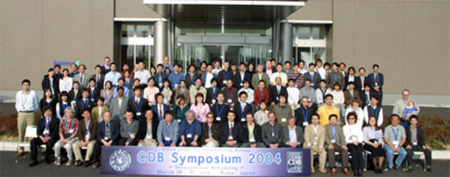| RIKEN Center for Developmental Biology (CDB) 2-2-3 Minatojima minamimachi, Chuo-ku, Kobe 650-0047, Japan |
April 6, 2004 – The RIKEN Center for Developmental Biology (CDB; Kobe, Japan) hosted its second annual symposium on March 29 to 31 in a newly completed lecture theater. The meeting addressed a broad range of subjects relating to the plasticity of biological systems, featuring talks by a panel of invited speakers recognized for preeminent contributions in their research fields, as well as poster presentations and short talks from selected poster submissions. The CDB’s program of holding annual symposia was launched in 2003 with the aim of fostering the exchange and discussion of recent findings, progress and trends in developmental biology, regeneration and related fields.
The three-day program began on Monday morning with a pair of morning sessions on nuclear reprogramming, highlighted by a review of the genetic underpinnings of DNA methylation (En Li; Novartis Institute for Biomedical Research, USA), an overview of the technical challenges and developmental abnormalities associated with cloning and nuclear transfer (Teruhiko Wakayama; RIKEN CDB, Japan), and a look at proteins involved in nucleolar disassembly during oocyte reprogramming (Nobuaki Kikyo; University of Minnesota, USA). The later afternoon sessions focused on chromatin dynamics, with talks on the function of histone variability in assembly of the nucleosome (Steven Henikoff; Fred Hutchinson Cancer Research Center, USA), and the roles of chromodomain proteins in the methylation of three heterochromatic regions in yeast (Jun-ichi Nakayama; RIKEN CDB, Japan). A third talk looked at plant epigenetics, describing the mechanism by which an endogenous transposon is repressed by DNA methylation in Arabidopsis. The day’s final talk illustrated the interaction between genes and non-coding regions in the epigenetic maintenance of transcriptional memory in Drosophila (Renato Paro; ZMBH, University of Heidelberg, Germany). The day was capped off by a reception dinner at the Institute for Biomedical Research and Innovation adjacent to the CDB. The second day’s talks concentrated on tissue plasticity in three sessions running until late in the afternoon. The morning’s first talk unveiled a new model proposing discrete, conformation-dependent activities for beta-catenin in transcription and cell adhesion (Barry Gumbiner; University of Virginia, USA). A discussion of the regulation of linker proteins in epithelial-mesenchymal transitions followed later in the same session (Richard Fehon; Duke University, USA). The second session of the day included a presentation of findings on “inflammatory” genes in epithelial morphogenesis, a process with strong parallels to wound healing (Paul Martin; University of Bristol, UK). The third session on tissue plasticity showed the roles of cell growth in the formation of the heart (Takashi Takeuchi; Mitsubishi Kagaku Institute of Life Sciences, Japan) and of cell migration during the embryonic process of gastrulation, in which the three germ layers first become distinct (Naoto Ueno; National Institute of Basic Biology, Japan). An early evening session on morphogenesis, opening with an overview of the dual roles of specific steroid receptors as transcriptional repressors and activators in insect metamorphosis (James Truman; University of Washington, USA) ended the day’s program. The technical highlight of the meeting came when Donald Brown of the Carnegie Institution of Washington (USA), who was unable to attend in person, delivered his talk on remodeling during amphibian metamorphosis by telephone. Regeneration and morphological remodeling were the themes of the sessions on Day 3. The first talk addressed the dual processes of myotube reorganization and positional memory along the proximo-distal axis in urodele limb regeneration (Jeremy Brockes; University College London, UK), which was followed by a survey of the extrinsic signals that determine dorsal-ventral identity in the regenerating spinal cord of the salamander. A third presentation, describing the development of an experimental system for the investigation and modeling of vertebrate limb regeneration as a series of progressive stages, rounded out the field (Susan Bryant; University of California-Irvine, USA). The final session looked at remodeling in an evo-devo light, with summaries of evolutionarily conserved mechanisms of vertebrate limb and fin positioning (Koji Tamura; Tohoku University, Japan) and an introduction to the topobiological mechanisms at work in feather development (Cheng-Ming Chuong; University of Southern California, USA). The third annual CDB Symposium, on the Origin and Development of the Vertebrate Traits, will be held at the CDB from April 11 to 13, 2005.
|
||||
|
||||
[ Contact ] Douglas Sipp : sipp@cdb.riken.jp TEL : +81-78-306-3043 RIKEN CDB, Office for Science Communications and International Affairs |
| Copyright (C) CENTER FOR DEVELOPMENTAL BIOLOGY All rights reserved. |
